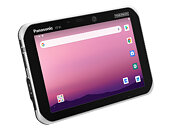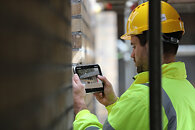Tuesday, May 18th 2021
Panasonic Introduces TOUGHBOOK S1 - the Ultimate Rugged Android Tablet
Panasonic today introduced the TOUGHBOOK S1 tablet - the ultimate rugged Android tablet for the truly mobile worker. This 7 inch screen device is easy to use in one hand, adaptable for a variety of tasks yet powerful and tough enough to cope with the busiest shift. It's at its best when in the hands of security and police forces patrolling the streets, technicians monitoring production lines, field services engineers carrying out inspections and maintenance or construction workers on site.
"The modern mobile worker deserves a mobile computing device designed for their everyday needs - not just another consumer tablet in a hardcase with all the potential problems they bring," said Baris Koc, European Product Manager for rugged mobile IT at Panasonic. "The TOUGHBOOK S1 is that professional mobile workforce device. It's built without compromise to meet the very specific and practical everyday needs of both the users and the IT administrators deploying and maintaining them."The TOUGHBOOK S1 tablet is ergonomically designed and lightweight (426 g) and with or without a handstrap it fits conveniently and comfortably in one-hand for use over long periods of time. Even in all weather conditions, the outdoor readable display is easy to use with a market-leading brightness of up to 500 cd/m² and enhanced anti-reflection technology ensuring clarity in the brightest sunlight. Rainy days and the need to remove safety gloves are also operational problems of the past when working with the TOUGHBOOK S1 tablet because of its effective rain-mode and glove-enabled touch screen. For those needing to capture signatures or complete reports or forms, the optional stylus pen is accurate and easy to use.
The device is flexible for the different needs of mobile workers and can be optionally equipped using its configurable gadget port offering combinations of bar code reader or additional USB port. A 13MP rear camera with flashlight and a front 5MP camera are ideal for capturing images to attach to reports and for video conference calls with colleagues.
To ensure the rugged tablet can work as long as any shift, it is equipped with a simple click and switch design for warm swapping batteries. It takes away the need to interrupt work, power down the device or remove fiddly panels to change batteries. With two options of battery size, the device can operate for up to 14 hours on a single charge.
Powerful enough to handle the application needs of any mobile worker, the device uses the Android 10 operating system and is equipped with a Qualcomm SDM660 Octa-Core CPU and 4 GB of RAM memory and 64 GB of storage.
Despite its ergonomic and lightweight design the tablet has all the protection expected of a fully rugged TOUGHBOOK device with a dust and water rating of IP65/67, MIL-STD-810H certification and tested to withstand drops of up to 150 cm onto concrete. For effective utilisation of accessories, the TOUGHBOOK S1 tablet shares elements of the TOUGHBOOK L1 and A3 Android tablet ecosystem, such as batteries, cradles, docks and stylus pens.
For ease of management and administrative peace of mind, the TOUGHBOOK S1 tablet is Android Enterprise-ready and comes bundled with the Panasonic COMPASS suite of Enterprise Management tools. The Complete Android Services and Security package offers everything a business needs to configure, deploy and manage its Panasonic rugged Android devices securely.
The TOUGHBOOK S1 tablet comes with a standard 3 year warranty and is available immediately. Prices start from €1,110 / £1,004 + VAT. For more information visit www.toughbook.eu.
"The modern mobile worker deserves a mobile computing device designed for their everyday needs - not just another consumer tablet in a hardcase with all the potential problems they bring," said Baris Koc, European Product Manager for rugged mobile IT at Panasonic. "The TOUGHBOOK S1 is that professional mobile workforce device. It's built without compromise to meet the very specific and practical everyday needs of both the users and the IT administrators deploying and maintaining them."The TOUGHBOOK S1 tablet is ergonomically designed and lightweight (426 g) and with or without a handstrap it fits conveniently and comfortably in one-hand for use over long periods of time. Even in all weather conditions, the outdoor readable display is easy to use with a market-leading brightness of up to 500 cd/m² and enhanced anti-reflection technology ensuring clarity in the brightest sunlight. Rainy days and the need to remove safety gloves are also operational problems of the past when working with the TOUGHBOOK S1 tablet because of its effective rain-mode and glove-enabled touch screen. For those needing to capture signatures or complete reports or forms, the optional stylus pen is accurate and easy to use.
The device is flexible for the different needs of mobile workers and can be optionally equipped using its configurable gadget port offering combinations of bar code reader or additional USB port. A 13MP rear camera with flashlight and a front 5MP camera are ideal for capturing images to attach to reports and for video conference calls with colleagues.
To ensure the rugged tablet can work as long as any shift, it is equipped with a simple click and switch design for warm swapping batteries. It takes away the need to interrupt work, power down the device or remove fiddly panels to change batteries. With two options of battery size, the device can operate for up to 14 hours on a single charge.
Powerful enough to handle the application needs of any mobile worker, the device uses the Android 10 operating system and is equipped with a Qualcomm SDM660 Octa-Core CPU and 4 GB of RAM memory and 64 GB of storage.
Despite its ergonomic and lightweight design the tablet has all the protection expected of a fully rugged TOUGHBOOK device with a dust and water rating of IP65/67, MIL-STD-810H certification and tested to withstand drops of up to 150 cm onto concrete. For effective utilisation of accessories, the TOUGHBOOK S1 tablet shares elements of the TOUGHBOOK L1 and A3 Android tablet ecosystem, such as batteries, cradles, docks and stylus pens.
For ease of management and administrative peace of mind, the TOUGHBOOK S1 tablet is Android Enterprise-ready and comes bundled with the Panasonic COMPASS suite of Enterprise Management tools. The Complete Android Services and Security package offers everything a business needs to configure, deploy and manage its Panasonic rugged Android devices securely.
The TOUGHBOOK S1 tablet comes with a standard 3 year warranty and is available immediately. Prices start from €1,110 / £1,004 + VAT. For more information visit www.toughbook.eu.



18 Comments on Panasonic Introduces TOUGHBOOK S1 - the Ultimate Rugged Android Tablet
companies are funny.
Work gloves on the other hand: are of all types. Maybe one group is using rubber, another is using leather, and another may be using latex. Gloves are also bad for precision, so I can't imagine that its a resistive screen.
So I'm not exactly seeing how that tech would work. Maybe its capacitive, but they tested a whole bunch of different work-gloves to tweak the algorithm? Even then, a lot of gestures (ex: single finger, double-finger, zoom, etc. etc.) require a decent amount of precision. Its probably easier to make gloves that have similar capacitance to a human... rather than to tweak the algorithm to recognize a bunch of other gloves.
But yeah...
* 7" WXGA, 500nit. Probably a generic IPS, which nowadays are only used in industrial touch panels, fridges, and fancy coffee machines. Heck, even a coffee machine in a grocery store downstairs uses a 6" FHD module. Probably the same thing I've seen time and time again 10 years ago in those shitty $30 chinese tablets.
* 3200mAh battery, while 5800mAh is an expensive[!!!] extra (>$130, if it's similar or same as last year's A3)
* QC is an extra[!!!]. That puny 3.2Ah battery charges in 3 hours, so I assume it's your ghost of the past decade 5V 1A cheap-o charger in base config
* Type C and docking connector are extra[!!!]
* SD660 in 2021? Not even 662 or 665? C'mon...
* 1 year limited warranty? For a rugged? For €1100? Wu-u-u-ut?Well, it's very stable, polished and still getting updates (and will get security updates at least for another year or so, just enough to last 1y. warranty), so it's the least of questionable things on the list. Heck, I'm still rocking Nokia 8 with Android 9, and everything works as good as intended. Though, last security patch was from Oct 1, 2020 and it's time to upgrade.
Also, Android 10 is only there thanks to Google.
www.gsmarena.com/google_will_require_all_devices_launched_after_january_31_2020_to_run_android_10-news-39526.php
If it was up to Panasonic, they'd be still running Nougat. :DIt's a glove touch "mode", so it's probably just a high-sensitivity mode toggled manually, kinda like old Galaxy Note digitizers, which could be used even with long nails instead of fingertips (used to be my aunt's favorite feature :laugh:)
That said:This does seem really odd.
Let's say, for HP it was something like 3 years mainstream and 5 years premium, and now it's down to 1 year and 3 years respectively, but today a top-end Elitebook equivalent costs like a barebones probook of yesteryear. Same with Thinkpads and Latitudes. Gotta cut costs to remain competitive.
In case of Panasonic, they've dropped from 3 year standard to 1 year, but the price remained the same(e.g. ridiculously high). Just clinging to those sweet-sweet exclusive military and industrial contracts in US.
Regardless, 500 nits is a shame, and slow charging is a shame too.
Companies who go dell (rugged laptops I mean) usually regret the choice. Dell makes decent hardware if you think consumer-wise, but in military, construction, police etc. you need to be able to "count" on your hardware, and can't have some shitty quality assurance issues or the hardware randomly dying (because of a bad batch or whatever).
If you'd check out forums about rugged laptops, you could find out that Dell is at most considered once, then never again, because it doesn't pass the test of time and reliability.
Something Panasonic is actually the best in, as far as I know. There are also other brands that are decent though, but they aren't Dell.
The money that is spent on such laptops/tablets is not really towards fast performance hardware, rather, the ruggedness of the case and internal components, as well as quality assurance tests, so there are no bad batches (this step is completely omitted in consumer products, because it's too expensive and if a consumer buys it he can just waste some time to replace it). Research and development of such cases is much more expensive than a standard case.
Whether prices are fair or not I don't know, Panasonic is actually the most expensive rugged brand, there are cheaper and they withstand way more than any generic consumer/business laptop. Nonetheless, I'd say the price is somewhat justified.
These are laptops for specific fields anyway, it's not like it would be worthwhile buying them personally. You'd better buy a Thinkpad and replace it every once in a while if needed at all. Would be much cheaper.
And android isnt iOS, it doesnt matter what OS you're on. Were FINALLY getting to the point where many popular apps no longer support 4.4.4. In the year of android 11.I disagree. Their consumer stuff is total garbage. Batteries that fall apart after a year, cheapo plastics, 0 maintenance capability, terrible HDDs and Dram less SSDs. Garbage images loaded with bloatware.
Their business line? Hardly any better. Bulging batteries, burnt out motherboards, failed WiFi antennaes. We've had nothing but trouble for the last 2-3 years with latitude laptops.
The issue is no other OEMs care enought o build a decent product anymore. It's all disposable.
The issue is: google is still in the process of managing and unifying android distros and updates, so they are tightening the noose on how far back android will be supported. Right now Android 10 is a requirement for all google-validated devices(the ones allowed to use Google Services). Same goes for App support - it's easier to target a narrow range of Android API levels, which in turn makes it easier to manipulate developers into using certain features, which in its turn makes it easier to manipulate userbase.Well, Apple is going the same way, especially after M1 release. At this moment they've stopped updating OS for some hardware, and stopped supporting lots of older software. Just a few weeks ago I had a client with an older iMac(2nd gen i7), and at this moment he has Yosemite installed, but 99% of software he uses is already locked out to OS X Mojave and higher.
Some older devices like 4th gen iPad Retina will nag about new updates only to tell you that the update is "not compatible with your device". So much for last year's praise for long-term support.
Also had an old MBP from another client not too long ago which came with El Capitan, but it couldn't be reinstalled on a new SSD right away because Apple hasn't updated a security certificate for this download since the date of last revision (you have to change system date/time to 2018 in order to install it). There are many more examples, but i'm not a frequent apple user to list more off the top of my head.
Actually if google doesnt allow google srvices on new devices running 9 I'd be mroe interested in a google-less android 9 device then a googled andorid 11 device. Especially given the mucking around google is doing with the SD card now. I used to be one of those guys who wanted better update policies, but over time I've realized they dont honestly amount to anything, given apps are sandboxed and update independent of the OS and any time I've lost data it has been due to a server being compromized, not a phone.Isnt that the opposite way? Android will let you install brand new apps on old phones no issue, apple has always been anal about you having the newest iOS to get app updates. I guess my point was this device shipping with andorid 10 really isnt an issue from a service standpoint given how long it will be until android 11 is a minimum target for new apps, it'll likely be 2030 or so, and I doubt these tablet swill still be in use by then. Android 5 is 7 years old and still sees active app support.
AOSP was good about 4-5 years ago. Now Google forced it to shrivel to a bleak shadow of its former self. Just give it a few more years and the only thing you'd be able to do on your AOSP smartphone is make calls. And if you think of alternatives - look no further than Huawei or chinese degoogled versions of MIUI (hint - abysmal and glitchy AF).